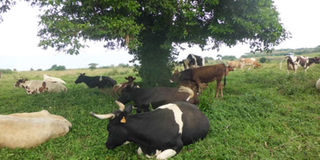Inside Entebbe bank where genes of animal breeds are conserved

Resting. The bulls at the bull stud in the gene bank at Entebbe used for extraction of semen. Photos by Lominda Afedraru
Most herders in Uganda and other Eastern Africa countries still rely on production of cattle in their ranch using the traditional method of cows mating with bulls.
However, with scientific innovations and technologies coming on board, this method has to be changed by farmers embracing artificial insemination practices to obtain improved breeds.
As such, scientists at the National Animal Genetic Data Bank in Entebbe have embarked on breeding bulls and cows where the former can be used by farmers through artificial insemination.
The extracted semen is kept in liquid nitrogen which are availed in the various veterinary offices to the districts for farmers to use.
Dr Hellen Ndagire, the programme officer-in-charge of artificial insemination at National Animal Genetic Resources Centre and Data Bank (NAGRC&DB), explains modalities of how to go about with the process of breeding bulls for extraction of semen and the purpose of the country having a gene bank.
She says: “World over, scientists majoring in animal breeding are setting up gene banks with the aim of conserving biodiversity, which includes, among others, local animal breeds in order not to get extinct.”

Sample. Mr Sirage Luwagu, the manager of bull stud, demonstrates how semen is handled in a laboratory.
Need for animal gene banks
The executive director of NAGRC&DB, Dr Charles Lagu, explains that in the implementation of the global action plan for animal genetics resources for food and agriculture, it is important for countries to set up gene banks to preserve animal species.
For this matter in Africa, Uganda has been selected to host the Eastern Africa Regional Gene Bank that will serve the countries of Burundi, Comoros, Djibouti, Eritrea, Ethiopia, Kenya, Somalia, South Sudan, Sudan, Rwanda and Tanzania.
“Animal genetic resources for food and agriculture are essential for Africa’s food security, and contribute to the livelihoods of millions of people. Recognising the importance of gene banking in the conservation of animal genetic resources, governments and the international community have agreed, through the Global Plan of Action (GPA) for Animal Genetic Resources, on the need for concerted and collaborative action at regional and continental levels,” Dr Lagu says.
He adds that animal gene banks provide storage facilities for germplasm, which include local and exotic breeds.
The gene bank comprises a laboratory meant to conserve sperms and embryos from important animal species for future use.
For the case of Uganda, DRC, Rwanda, Tanzania and Burundi, emphasis is put on the Ankole long-horn cattle and the East African short-horn Zebu.
Other countries have their animals of priorities and these include Zeko breed for Ethiopia, Pari goats for Kenya and Mubende goat breed specifically for Uganda.
Dr Lago says Uganda was chosen to host the regional bank because it has scientists who are capable of handing the conservation exercise and there are existing facilities across the country where animals are being bred and kept in the different farms.
The institution has a total of 12,000 head of cattle and 3,000 goats, both exotic and local breeds.
Dr Lagu explains that NAGRC&DB was established with a two-fold mandate, namely; to play a leading role in the commercialisation of animal breeding products in Uganda and to carry out development activities that enhance animal Genetic improvement and productivity.
The commercial activities included availing semen for sale, eggs of chicken, ova and embryos, management of farms for production, selection and sale of superior rams and sires, rearing of sire studs for production and sale of semen, production and sale of liquid nitrogen and associated equipment.
Other activates are production and sale of founder brood stock of fisheries resources, offer for sale properly bred stock through pathways such as open nucleus schemes and procurement and sale of other breeding and reproduction equipment.

Breed. One of the hybrid cows.
The genetic resource farms
The various farms include Rusenke in Kayunga, Kasolwe in Kamuli and Bulago in Mubende. Those in northern Uganda are Saga, Maruzi and Aswa farms. Others are Ruhengeru in Kiruhura, Rubona in Mbarara, and Inshara range. The one in eastern Uganda is Njeru in Jinja District.
Breeding bulls and semen production
The manager of bull stud at NAGRC&DB, Mr Sirage Luwagu, explains that usually his team identifies high quality bulls which are disease-free and have not yet engaged in mounting with cows. They are then recruited for training.
He says it is also important to check the genital system, the mating behaviour and that there is a way the bulls are teased to assess the level of libido.
The next training is to subject the bulls to an artificial vagina so that the bulls feel they are actually ejaculating semen while mating with a cow. They are taught how to mount fellow bulls through teasing them.
Semen processing and handling
When collecting semen, two bulls are selected and the one acting as a teaser is driven to a cattle crush to keep it still.
The donor will then jump onto it but instead of ejaculating on the teaser bull, it will ejaculate in the artificial vagina.
The artificial vagina is prepared prior with a lubricant to keep it soft and it is kept warm. Scientists ensure the jelly used is favorable in order to keep the sperm cells alive to cause fertilisation when artificial insemination is conducted.
When the bulls ejaculate and semen is collected, it is stored in a tube, which must immediately be kept in an extender containing nutrients such as salt to keep the sperm alive, as well as increase the number of doses.
This is kept in water at 37 degrees centigrade throughout the processing period to enable the semen to cool.
Scientists do examine the semen under microscopes and it is diluted with extender to get numerous sperm cells which can perform fertilisation at the time when inserted in cows.
In one dose, there are 20 million sperm cells to fertilise one ovary and others die along the way during fertilisation.
Packaging of sperms and storage
Once the semen is processed and diluted to the required dose, it is kept in a refrigerator for five minutes before it is transferred to the packaging machine.
The semen packaging machine is computerised and once it is switched on, the computer identifies the breed of the bull, its name and number and the information is automatically printed on the straw on which the sperm is packaged.
The straws are then frozen in liquid nitrogen under -110 degrees Celsius. The straws are spread on racks. The freezing chamber can handle 2,500 doses at once.
Scientists are able to make 600 doses from one bull per day.
Once the sperm cells are frozen, they are then kept in liquid Nitrogen at -196 degrees Celsius. It takes about eight minutes for the sperm cells to be frozen and finally it is transferred in the nitrogen gas flasks, which is capable of keeping the sperm cells for more than 100 years because as long as it is kept in liquid Nitrogen, it cannot get spoilt.
At the moment, the gene bank contains 26 bulls for semen collection. It takes five to six years for them to grow to execute their function. The institute also keeps cows for dairy production and these are not mixed with the bulls. The breeds available are able to produce 32 litres of milk or more per day and most of them are exotic breeds.

Storage. Once the semen is processed and diluted to the required dose, it is kept in a refrigerator for five minutes before is transferred to the packaging machine. The semen packaging machine is computerised and once it is switched on, the computer identifies the breed of the bull, its name and number and the information is automatically printed.
Types of breeds
Currently, the gene bank comprises dairy cattle which include Jersey, Ganje and Ayrshire. The duo-purposes breeds are Brown Swiss and Sahiwal and those for beef are Boran and Brahman.
The bulls for semen extraction include Black and White Friesians, Jersey, Heifer and Akole cattle.
The team also imports semen from other countries from breeds such as Angus and Limousine, among others which are of Italian origin.
Other animals kept for genetic conservation are Mubende and Kigezi goats.
How to take care of animals
Mr Luwago says it is important to feed the animals daily using napier grass, which can be in its natural form in form of hay and silage.
“Give them concentrates of mixed maize husk cake, sunflower cake and salt. It is important to give them drinking water. This is done on daily basis. It is also important to spray them with recommended acaricides to prevent parasites such as ticks, flees and termites,” he says.
The role of the regional lab
Mr Moses Solimo, a biotechnology scientist in-charge of the regional lab at Entebbe, explains that scientists will be in position to harvest embryos from cows across the region, study its efficacy and store it in liquid nitrogen for conservation.
This, he says, is important for Ugandan breeds because in years to come, if the animal breeds face a challenge of extinction, scientists will be able to breed more using artificial insemination.
The lab will also act as source of data for all genetic make ups of animals in the Eastern Africa countries, which information can be used in breeding initiatives.
Farmers and scientists engagement
Dr Ndagire says since artificial insemination is a technical application, it is important for farmers to engage veterinary doctors to perform it on cows.
The stock farm for the bulls is in selected sites across the country, namely Rubona in western Uganda, Lusenke Stock Farm in Kayunga and Kasoluwe Stock Farm, among others.
Some of them are used to train scientists and interested farmers on how to perform artificial insemination on cows. The scientists are entitled to transfer bulls with good features to Entebbe to be trained for collection of semen.
Species
The gene bank comprises a laboratory meant to conserve sperms and embryos from important animal species for future use.
For the case of Uganda, DRC, Rwanda, Tanzania and Burundi, emphasis is put on the Ankole long-horn cattle and the East African short-horn Zebu. Other countries have their animals of priorities and these include Zeko breed for Ethiopia, Pari goats for Kenya and Mubende goat breed specifically for Uganda.



